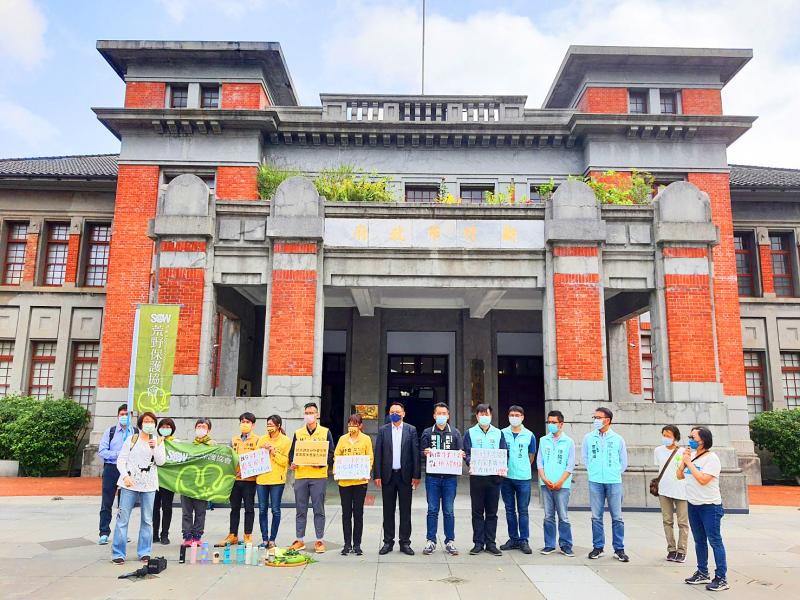The Hsinchu City Council yesterday passed the Hsinchu City Ordinance on Wastewater Discharge Management (新竹市廢水及污水排放管理自治條例), following a referendum last year on the issue.
The referendum on Dec. 18 last year passed with 131,816 yes votes on the question: “Do you agree that the Hsinchu City Government should draft a wastewater management ordinance that would clearly state that industrial, medical and wastewater from other sources should be collected by a dedicated pipeline, the outtake of which should not empty into the intake areas of potable water or upstream of irrigation water intakes?”
The city government yesterday said it had met with local groups, as well as local branches of the Irrigation Agency, to discuss how best to draft the legislation and address the majority view reflected in the referendum.

Photo: Hung Mei-hsiu, Taipei Times
The ordinance seeks to separate drinking water, water used for irrigation and wastewater, the city government said, adding that it is considering civic groups’ suggestions to set up an oversight committee, which would include experts, local groups and city government officials as members.
The city mayor would chair the committee and a meeting would be convened every six months, with extraordinary meetings being held when necessary, an addendum says.
The regulatory details for the establishment of the said committee should be reviewed and ratified by the city council, the addendum says.
Outside Hsinchu City Hall, the Taiwan Clear Water Action Alliance held a rally calling for separate pipes to be set up for industrial waste, medical waste and wastewater produced by other means.
The alliance added that these pipes should not empty into intake areas for potable water or upstream of irrigation water intakes.
The government should start by tackling industries and businesses found to be dumping wastewater, the alliance said, while calling for the establishment of a clause that would allow the city government to file claims to recover illegal gains.

Taiwan is to commence mass production of the Tien Kung (天弓, “Sky Bow”) III, IV and V missiles by the second quarter of this year if the legislature approves the government’s NT$1.25 trillion (US$39.78 billion) special defense budget, an official said yesterday. Commenting on condition of anonymity, a defense official with knowledge of the matter said that the advanced systems are expected to provide crucial capabilities against ballistic and cruise missiles for the proposed “T-Dome,” an advanced, multi-layered air defense network. The Tien Kung III is an air defense missile with a maximum interception altitude of 35km. The Tien Kung IV and V

The disruption of 941 flights in and out of Taiwan due to China’s large-scale military exercises was no accident, but rather the result of a “quasi-blockade” used to simulate creating the air and sea routes needed for an amphibious landing, a military expert said. The disruptions occurred on Tuesday and lasted about 10 hours as China conducted live-fire drills in the Taiwan Strait. The Civil Aviation Administration (CAA) said the exercises affected 857 international flights and 84 domestic flights, affecting more than 100,000 travelers. Su Tzu-yun (蘇紫雲), a research fellow at the government-sponsored Institute for National Defense and Security Research, said the air

A strong continental cold air mass is to bring pollutants to Taiwan from tomorrow, the Ministry of Environment said today, as it issued an “orange” air quality alert for most of the country. All of Taiwan except for Hualien and Taitung counties is to be under an “orange” air quality alert tomorrow, indicating air quality that is unhealthy for sensitive groups. In China, areas from Shandong to Shanghai have been enveloped in haze since Saturday, the ministry said in a news release. Yesterday, hourly concentrations of PM2.5 in these areas ranged from 65 to 160 micrograms per cubic meter (mg/m³), and pollutants were

Taiwan’s armed forces have established response protocols for a wide range of sudden contingencies, including the “Wan Chun Plan” to protect the head of state, the Ministry of Defense (MND) said today. After US President Donald Trump on Saturday launched a series of airstrikes in Venezuela and kidnapped Venezuelan President Nicolas Maduro, concerns have been raised as to whether China would launch a similar “decapitation strike” on Taiwan. The armed forces regularly coordinate with relevant agencies and practice drills to ensure preparedness for a wide range of scenarios, Vice Minister of National Defense Hsu Szu-chien (徐斯儉) told reporters before a